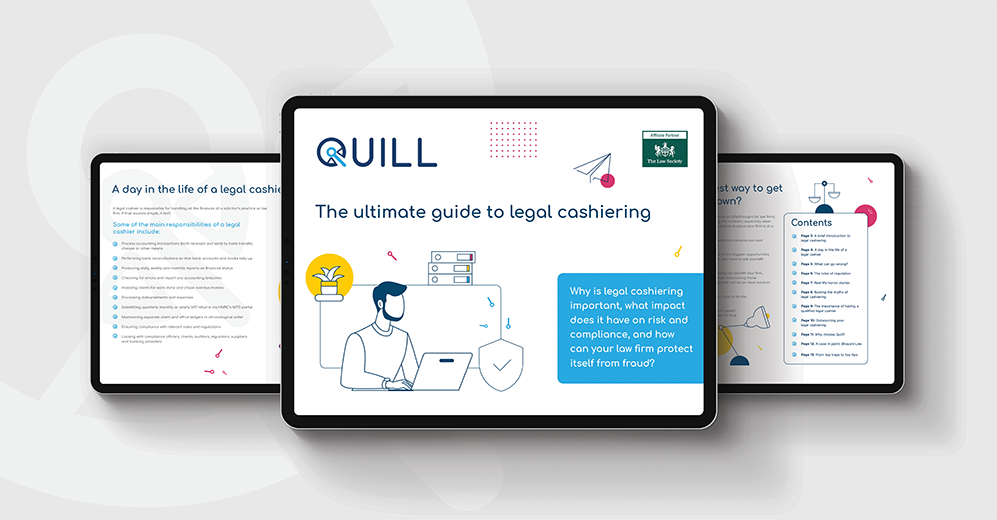
Guide to Starting Your Own Law Firm: Steps 9-10
17/12/20Today’s how to start your own law firm blog series is focused on steps 9 to 10: how to create a realistic cashflow forecast and understand your accounting responsibilities.
In our series ’15-Step Guide to Starting Your Own Law Firm,’ we’ve covered steps 1 to 3 (opening a bank business account, purchasing Professional Indemnity Insurance and formulating your business plan), step 4 (building risk management and compliance into your plan), and steps 5 to 8 (taking the plunge, formally applying, choosing your business structure and managing client accounts).
Today’s how to start your own law firm blog series is focused on steps 9 to 10: how to create a realistic cashflow forecast and understand your accounting responsibilities. These are crucial steps to ensure you’ve got a healthy enough flow of money to keep your business afloat and guarantee you don’t fall foul of poor bookkeeping which can land you in hot water with regulatory bodies.
This timely guide will help you to tackle these all-important finance-related duties and get your new enterprise off the ground.
WATCH WEBINAR:
Step 9: Create a realistic cashflow forecast
Cashflow and funding are critical calculations – potential killers, in fact, for any law firm.
“This is acutely accurate – profitable law firms have failed because of a lack of cashflow but what’s not always known is that cashflow is the endpoint of a legal practice’s working capital cycle,” explains Joel Topham, Senior Manager, Sagars Accountants Ltd.
Each stage ‘costs’ in either time or cash (or both) and the management of the cycle will determine the success or failure of a legal practice from a financial point of view.
The length of the cycle will depend on the type of work you are doing, the nature of your clients and your ability to stay on top of each process. This will also determine the funding requirement of your business.
“It’s essential to create a realistic cashflow forecast so you can see exactly how much money it will take to set up and run your law firm. It is important to budget sensibly for the build-up of income either, because it takes time to generate new business, or for existing clients to pay you,” says Joel Topham.
“The SRA and your funder will want to see accurate forecasts for the cashflow for your business. You will also want to know that your law firm will genuinely be profitable and that you have enough money behind you to start the business and sustain yourself during its infancy.”
While planning your finances, you also need to set money aside for taxes, business registration fee and other licensing fees. Research the various business tax liabilities in your region and when these liabilities are due. Ensure that you have allocated sufficient funds to meet these obligations.
You’ll need to establish how you want to bill your clients – fixed or hourly, the rates, the billing cycle and the payment terms. If you’ve hired full-time or part-time staff, you need to account for employee compensation within your costs as well.
When James Brown and Sam Hall set up their two-partner law firm, Hall Brown Family Law, they focused on ascertaining fee income which could realistically be generated in their first year of trading.
James explains: “To Sam and me, ‘generated’ meant not what we had billed but the work that had been introduced to us as individuals. We then divided it by two. This way we had a double safeguard – this being length of time and assuming a 50% decrease – which produced a figure we could be absolutely confident about. Using this figure, as we calculated our overheads. We then knew that if there was a margin left at the end, we had a viable business. If not, we didn’t.
“The other strand to this undertaking, we wrote two lists onto sticky notes – what we wanted to be to clients and what we wanted to be to staff. This was and continues to be the ‘essence’ of our firm. We’re five years in and have grown from two people to 45 and from £0 to £4.5 million turnover, yet we still use these lists as guiding principles for every decision we make.”
“Last but not least, make sure you have a core group of loyal clients and referrers of work who will guarantee you a sufficient level of work to enable you to plan at least the next 12 months,” advises Laura Devine, principal of immigration firm Laura Devine Solicitors. “Have a viable business plan for developing the new firm for the longer term. It should be based on there being a sustainable and growing market for your services in which you are confident that you can compete with the elite in your area of work.”
DOWNLOAD eBOOK:
Step 10: Understand your basic accounting, tax and filing responsibilities
“Very simply, if you don’t do these financial management jobs on time, you’re breaching your obligations, be it relating to SRA, HMRC or Companies House regulations. It’s a good idea to talk to the experts for support or outsource certain functions to specialists – such as Quill for payroll and cashiering – in order to assist with the fulfilment of these onerous responsibilities,” comments Julian Bryan, Quill.
If this is the first time you are setting up a law firm, be mindful that there will be things that you don’t know. Below is some helpful information provided by Sagars Accountants Ltd.
As a business owner, you will be responsible for filing accounts, paperwork and paying various business taxes to the HMRC on an annual or more regular basis. This is regardless of which structure you choose for the business — the structure simply determines when and where the accounts are required to be published.
Understanding your responsibilities:
Do this early as it’s essential to running your business properly, being legally compliant and avoiding hefty fines from the HMRC. This includes self-assessment tax, corporation tax, VAT and PAYE. Some of these deadlines start almost from the beginning of trading so you need to be on top of them.
You equally need to know how this information is to be submitted to HMRC as the vast majority of information is sent digitally to HMRC now and HMRC’s ongoing “Making Tax Digital” programme is only going to increase the volume of this.
Record your financial transactions regularly:
Businesses are legally required to keep an accurate and up-to-date record of their finances, including expenditure, income and any other financial transactions of the business. This not only will help you make crucial financial plans, but will make filing your accounts easier and quicker for your accountant.
Prepare and file annual accounts:
Limited companies and limited liability partnerships are required to submit accounts annually to Companies House. These accounts are a record of your business’s expenses, revenue and financial transactions across the accounting year. Sole traders and partnerships must also prepare accounts but these only need to be submitted to HMRC alongside the business’s tax returns. Your corporation tax bill will be worked out based on these accounts.
It’s recommended that an accountant prepares these accounts based on your accounting records from the year. Again, depending on how organised and up to date these records are, this can either be a simple or complicated process.
Register for self-assessment:
This is the annual filing of a set of simple accounts covering your income during the year, which the HMRC uses to assess the tax you need to pay personally. Sole traders, company directors and partners in a partnership will need to register for self-assessment (company directors will also need to know about PAYE and dividends). Sole traders can also use any business-related costs to reduce their income and overall tax bill. One exception is that if your limited company is not-for-profit, then you do not need to file self-assessment.
Register for VAT (Value Added Tax):
If your business is likely to have more than the VAT threshold in annual sales, you will need to register for VAT. This is a flat rate tax you must charge on top of any goods or services you sell. On the positive side, once you’re VAT registered and have your VAT number you can purchase products from other businesses VAT-free – from as far back as six months – to reclaim VAT on goods and services incurred prior to being registered.
There’s also an option to voluntarily register for VAT even if your turnover won’t exceed the VAT threshold, whilst this is an added layer of compliance it’s often financially advantageous to do this.
Register for corporation tax:
If you set up a limited company, you’ll be automatically registered for corporation tax within three months of incorporation. You will be assessed for corporation tax through your annual accounts and will need to pay a flat rate tax based on the profits generated by your business. You can find more details on paying corporation tax here.
Set up a payroll scheme:
Unless you are a sole trader, you will need to set up a payroll scheme. As a company, even if you do not have any employees you should set up a payroll scheme for tax reasons. Depending on whether you have employees will also determine if you need an auto-enrolment scheme and the associated compliance.
One word of caution: payroll compliance is the area with the most potential pitfalls for getting things wrong, so we strongly recommend you outsource to a specialist such as Quill Payroll or your accountant.
Understanding business rates:
Business rates are a tax levied on business premises by the Government and delivered by local authorities. They are charged annually on business properties including shops, factories, offices, warehouses, bars and more. If you own or rent commercial premises, you will likely to register for and pay business rates. However, if you are running your business from home it is unlikely you will need to pay business rates.
Tell Companies House and HMRC of any changes:
If you change your name, business name, personal or trading address or any other business details change, you must inform relevant authorities straightaway.
File a confirmation statement:
Limited companies and limited liability partnerships need to submit an annual confirmation statement, which simply checks that the information that Companies House has about your business is correct. If any is incorrect or out of date, you will need to update these details.
Download e book

More from our blog

17th December
Guide to Starting Your Own Law Firm: Step 4
Step 4 in starting your own law firm: how to build risk management and compliance into your business plan.

17th December
Guide to Starting Your Own Law Firm: Steps 5-8
Steps 5-8 on how to start your own law firm: why take the plunge, formally applying, choosing your business structure and managing client accounts.

17th December
Guide to Starting Your Own Law Firm: Steps 11-15
Steps 11-15 of how to start your own law firm in the UK covers: technology, where to practice, outsourcing legal services, and how to get your name out there through marketing.



